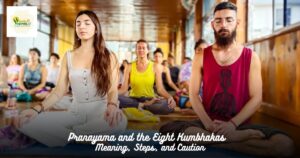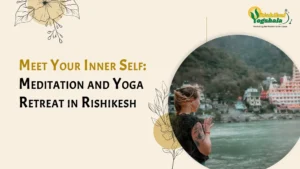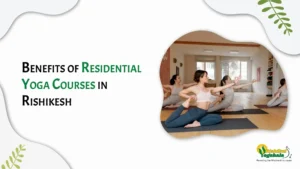Ashtanga yoga is highly effective in fostering physical strength and bringing forth emotional, energetic, and spiritual healing. This technique integrates the body’s motions with the breath in a rhythmic vinyasa flow.
However, it must be noted that this yoga can be slightly daunting if you are a beginner – but fear not! We’ve got everything covered in our 300 Hour Yoga Teacher Training in Rishikesh at Rishikul Yogshala Rishikesh program! Ashtanga Yoga Teacher Training also covers anatomy, philosophy, and yoga ethics to create well-rounded teachers.
But, for now, we’ve worked on this guide that will help walk you through the Ashtanga yoga poses for beginners, as well as their benefits.
Ashtanga Yoga For Beginners
This yoga is a highly athletic and energetic style of hatha yoga. It has its roots in vinyasa, which emphasizes energy and breath while moving between poses. This form of yoga encourages mental clarity and inner calmness despite being a very physical activity.

History of Ashtanga Yoga
This yoga is supposed to have been documented by Vamana Rishi, a sage who has no records. This yoga sequence is written in an old book known as the Yoga Korunta that covers the main principles of Ashtanga Yoga, like:
- Bandhas (energy)
- Vinyasa (breathing pattern)
- Mudras (gestures)
- Drishti (sight)
- Yogic philosophy
Components of Ashtanga Yoga
Releasing tensions via proper yoga practice is a wonderful and enlightening experience and has been taught by great masters. Among them was the guru Pantanjali, who charted an eight-stage road to enlightenment via yoga.
Basically, the term “ashta” means eight in Sanskrit, while the word “anga” means “limb”. When you combine them, you create Ashtanga, or the 8 limbs of yoga.
You get more capable with each limb. You can only proceed with the second and subsequent tasks if you have accomplished the first.
Here are the eight angas (limbs) of Ashtanga yoga:
- Yama (integrity)
- Niyama (discipline)
- Asana (posture)
- Pranayama (breathing)
- Pratyahara (withdrawal)
- Dharana (concentration)
- Dhyana (focus)
- Samadhi (ecstasy)
Ashtanga Yoga Benefits
The overall purpose of yoga is to achieve a consciousness of this mind-body link to the whole, without separation or duality, via the rigorous and committed practice of meditation and its ideals.

Although difficult, this exercise has a lot of advantages. They consist of, but are by no means limited to:
- Increased adaptability
- Improved power improved muscle tone
- Higher level of cardiovascular fitness
- Lower body fat
- Less worry and stress
- Enhanced concentration and creativity
- Blood pressure reduction
- Less vulnerable to injury
Now let’s move on to the most important part of the blog: Ashtanga Yoga Postures
Ashtanga Yoga Poses for Beginners
Here are some of the Ashtanga yoga poses that beginners can practice:
- Mountain Pose (Pranamasana)
- Sun Salutation (Surya Namaskar)
- Hand to Big Toe Pose (Padangusthasana)
- Standing Forward Bend Hands Under Feet Pose (Uttanasana Variation)
Mountain Pose
- Stand tall with your feet about a couple of inches apart.
- Straighten your legs by flexing your thighs.
- Lower your tailbone by moving your hips forward.
- Keep your spine straight by contracting your lower back and core.
- Stretch your torso by rolling your shoulders back.
- Your palms should be facing out when you extend your arms out to the sides.
- Your tongue should be wide and flat on the floor of your mouth, your throat should be soft, and the crown of your head should be squarely above the center of your pelvis. Relax your gaze. Breathe.

Sun Salutation (Surya Namaskar)
- A primary sun salutation is Surya Namaskar A. It includes Chaturanga Dandasana (four-limbed staff pose), Adho Mukha Svanasana (upward-facing dog), and Urdhva Mukha Svanasana (downward-facing dog).
- Next, perform Surya Namaskar B. This sun salutation requires a little more effort. Utkatasana (Chair Pose) and Virabhadrasana I (Warrior 1) are included.

Hand to Big Toe Pose (Padangusthasana)
- Start out in mountain position, but space your feet about hip distance apart. Arms are by the body’s side.
- Stretch the torso upwards and circle the arms in an upward motion as you inhale.
- When you exhale, keep your spine long, bend forward from the hips, and place your hands on the floor.
- Put your thumb on top of your big toe and place your index and middle fingers (in the peace sign) beneath. Pressing the big toes into the fingers while attempting to raise the toes with the fingers can cause stress. To the extent that you can go without overextending the knees, straighten the legs.
- Bending, outward-pointing elbows are used. The arms are still relaxed, and the shoulders are back from the ears.
- You stretch your spine with each inhalation and fold a little more into your position with each exhalation.
- To loosen, let go of the hold while keeping your body curled forward for a few breaths. After that, slowly begin rolling each vertebra back up.
Standing Forward Bend Hands Under Feet Pose (Uttanasana Variation)
- When you exhale, straighten your body and bend your hips forward. Your hands should be on the ground while you maintain length in the front of your body. As much as necessary, bend your knees.
- Turn your hands’ palms up and tuck them under the bottoms of your feet so that the wrist joint is at the base of your toes. To discover the right amount of weight for your hands and wrists, move the weight of your feet forward and backward.
- Option to extend your elbows out to the sides and forward after securing your hands with your feet. Keep your neck long.
- Before removing your hands from behind your feet and rising gently to your feet, stay for up to eight breaths.

To Conclude
Ashtanga yoga benefits are the main reason people are attracted to it, despite it being a difficult yoga. They offer strength, adaptability, and discipline.
But you must keep in mind that every experience involves a process. You too can easily practice the Ashtanga yoga poses with diligence and effort.
Incorporating this pose into your practice can lead to significant improvements in overall well-being. For those interested in deepening their yoga journey, consider enrolling in a yoga teacher training program. Rishikul Yogshala Rishikesh, a leading Yoga school in Rishikesh, offers comprehensive courses like the 200 Hour Yoga TTC in Rishikesh and the 300 Hour Yoga Teacher Training in Rishikesh. These programs are designed to help you master your practice and share the transformative power of yoga with others.
Ashtanga Yoga Poses – FAQs
What postures are in Ashtanga yoga?
There are many postures in Ashtanga yoga, but the Ashtanga yoga poses for beginners are: Mountain Pose, Sun Salutation A, Hand to Big Toe Pose, Standing Forward Bend, and Hands Under Feet Pose.
Why is Ashtanga yoga different?
It is a challenging kind of yoga that adheres to a set order of poses and is comparable to vinyasa yoga in that both relate each exercise to a breath. Ashtanga is different because it follows a sequence.
Which is better, Hatha or Ashtanga yoga?
Between Ashtanga and Hatha yoga, there are significant distinctions. The most popular form of yoga, Hatha, is excellent for beginners. On the other side, Ashtanga is a more vigorous and organized style of yoga. Their shared attention to the physical component of yoga is their primary point of similarity.
Last Modified Date: 27th September 2025













